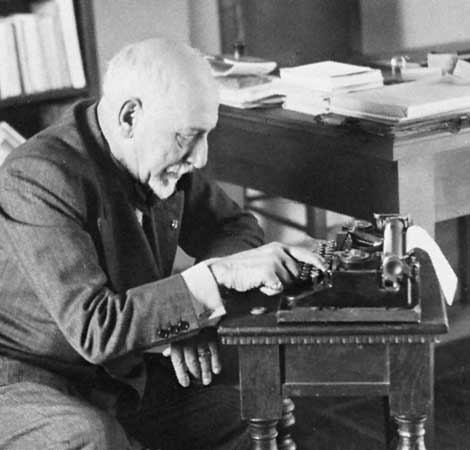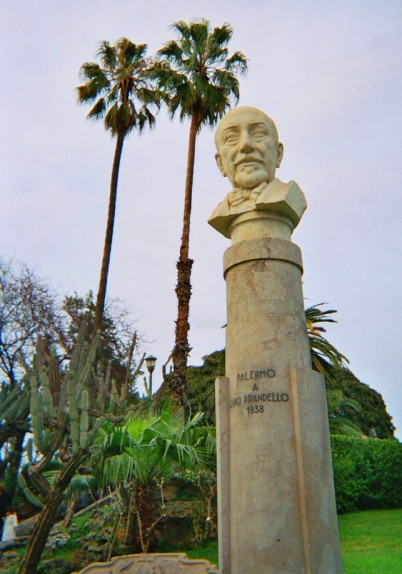<Back to Index>
- Physician Pierre Paul Broca, 1824
- Dramatist Luigi Pirandello, 1867
- 10th Prime Minister of India Pamulaparthi Venkata Narasimha Rao, 1921
PAGE SPONSOR
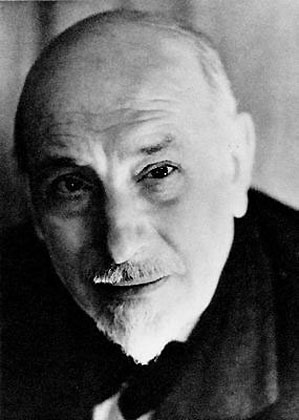
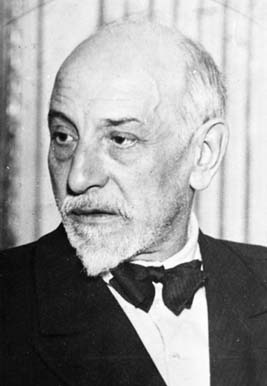
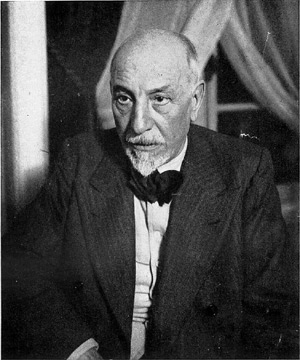
Luigi Pirandello (28 June 1867 – 10 December 1936) was an Italian dramatist, novelist, and short story writer awarded the Nobel Prize in Literature in 1934, for his "bold and brilliant renovation of the drama and the stage." Pirandello's works include novels, hundreds of short stories, and about 40 plays, some of which are written in Sicilian. Typical for Pirandello is to show how art or illusion mixes with reality and how people see things in a very different way — words are unreliable and reality is at the same time true and false. Pirandello's tragic farces are often seen as forerunners for the Theatre of the Absurd.
"A
man will die, a writer, the instrument of creation: but what he has
created will never die! And to be able to live for ever you don't need
to have extraordinary gifts or be able to do miracles. Who was Sancho
Panza? Who was Prospero? But they will live for ever because — living
seeds — they had the luck to find a fruitful soil, an imagination which
knew how to grow them and feed them, so that they will live for ever."
(from Six Characters in Search of an Author, 1921) Pirandello was born into an upper-class family in a village with the curious name of Kaos (Chaos), a poor suburb of Girgenti (Agrigento, a town in southern Sicily).
His father, Stefano, belonged to a wealthy family involved in the
sulphur industry and his mother, Caterina Ricci Gramitto, was also of a
well-to-do background, descending from a family of the bourgeois
professional class of Agrigento. Both families, the Pirandellos and the
Ricci Gramittos, were ferociously anti-Bourbonic and actively
participated in the struggle for unification and democracy ("Il Risorgimento"). Stefano participated in the famous Expedition of the Thousand, later following Garibaldi all the way to the battle of Aspromonte and
Caterina, who had hardly reached the age of thirteen, was forced to
accompany her father to Malta, where he had been sent into exile by the
Bourbon monarchy. But the open participation in the Garibaldian cause
and the strong sense of idealism of those early years were quickly
transformed, above all in Caterina, into an angry and bitter
disappointment with the new reality created by the unification.
Pirandello would eventually assimilate this sense of betrayal and
resentment and express it in several of his poems and in his novel The Old and the Young.
It is also probable that this climate of disillusion inculcated in the
young Luigi the sense of disproportion between ideals and reality which
is recognizable in his essay on humorism (L'Umorismo). Pirandello
received his elementary education at home but was much more fascinated
by the fables and legends, somewhere between popular and magic, that
his elderly servant Maria Stella used to recount to him than by
anything scholastic or academic. By the age of twelve he had already
written his first tragedy. At the insistence of his father, he was
registered at a technical school but eventually switched to the study
of the humanities at the ginnasio, something which had always attracted him. In 1880, the Pirandello family moved to Palermo.
It was here, in the capital of Sicily, that Luigi completed his high
school education. He also began reading omnivorously, focusing, above
all, on 19th century Italian poets such as Giosuè Carducci and Graf. He then started writing his first poems and fell in love with his cousin Lina. During
this period the first signs of serious contrast between Luigi and his
father also began to develop; Luigi had discovered some notes revealing
the existence of Stefano's extramarital relations. As a reaction to the
ever increasing distrust and disharmony that Luigi was developing
toward his father, a man of a robust physique and crude manners, his
attachment to his mother would continue growing to the point of
profound veneration. This later expressed itself, after her death, in
the moving pages of the novella Colloqui con i personaggi in 1915. His
romantic feelings for his cousin, initially looked upon with disfavour,
were suddenly taken very seriously by Lina's family. They demanded that
Luigi abandon his studies and dedicate himself to the sulphur business
so that he could immediately marry her. In 1886, during a vacation from
school, Luigi went to visit the sulphur mines of Porto Empedocle and
started working with his father. This experience was absolutely
essential to him and would provide the basis for such stories as Il Fumo, Ciàula scopre la Luna as well as some of the descriptions and background in the novel The Old and the Young. The marriage, which seemed imminent, was postponed. Pirandello
then registered at the University of Palermo in the departments of Law
and of Letters. The campus at Palermo, and above all the Department of
Law, was the centre in those years of the vast movement which would
eventually evolve into the Fasci Siciliani. Although Pirandello was not an active member of this movement, he had close ties of friendship with its leading ideologists: Rosario Garibaldi Bosco, Enrico La Loggia, Giuseppe De Felice Giuffrida and Francesco De Luca. In
1887, having definitively chosen the Department of Letters, he moved to
Rome in order to continue his studies. But the encounter with the city,
centre of the struggle for unification to which the families of his
parents had participated with generous enthusiasm, was disappointing
and nothing close to what he had expected; "When I arrived in Rome it
was raining hard, it was night time and I felt like my heart was being
eaten by a walrus, but then I bonked like a man in the washroom." Pirandello,
who was an extremely sensible moralist, finally had a chance to see for
himself the irreducible decadence of the so-called heroes of Il Risorgimento in
the person of his uncle Rocco, now a greying and exhausted functionary
of the prefecture who provided him with temporary lodgings in Rome. The
"desperate laugh", the only manifestation of revenge for the
disappointment undergone, inspired the bitter verses of his first
collection of poems, Mal Giocondo (1889).
But not all was negative; this first visit to Rome provided him with
the opportunity to assiduously visit the many theatres of the capital:
Il Nazionale, Il Valle, il Manzoni. "Oh the dramatic theatre! I will
conquer it. I cannot enter into one without experiencing a strange
sensation, an excitement of the blood through all my veins..." Because of a conflict with a Latin professor he was forced to leave the University of Rome and
went to Bonn with a letter of presentation from one of his other
professors. The stay in Bonn, which lasted two years, was fervid with
cultural life. He read the German romantics, Jean Paul, Tieck, Chamisso, Heinrich Heine and Goethe. He began translating the Roman Elegies of Goethe, composed the Elegie Boreali in imitation of the style of the Roman Elegies, and he began to meditate on the topic of humorism by way of the works of Cecco Angiolieri. In March 1891 he received his Doctorate under the guidance of Professor Foerster in Romance Philology with a dissertation on the dialect of Agrigento Sounds and Developments of Sounds in the Speech of Craperallis.
The stay in Bonn was of great importance for the young writer; it was
there that he forged the bonds with German culture that would remain
constant and profound for the rest of his life. After
a brief sojourn in Sicily, during which the planned marriage with his
cousin was finally called off, he returned to Rome, where he would
become friends with a group of writer-journalists including Ugo Fleres,
Tomaso Gnoli, Giustino Ferri and Luigi Capuana. It was Capuana who encouraged Pirandello to dedicate himself to narrative writing. In 1893 he wrote his first important work, Marta Ajala, which was published in 1901 with the title l'Esclusa. In 1894 he published his first collection of short stories, Amori senza Amore. 1894 was also the year of his marriage. Following his father's
suggestion he married a shy, withdrawn girl of a good family of
Agrigentine origin educated by the nuns of San Vincenzo: Antonietta
Portulano. The
first years of matrimony brought on in him a new fervour for his
studies and writings: his encounters with his friends and the
discussions on art continued, more vivacious and stimulating than ever,
while his family life, despite the complete incomprehension of his wife
with respect to the artistic vocation of her husband, proceeded
relatively tranquilly with the birth of two sons (Stefano and Fausto)
and a daughter (Lietta). In the meantime, Pirandello intensified his
collaborations with newspaper editors and other journalists in
magazines such as La Critica and La Tavola Rotonda in which he would publish, in 1895, the first part of the Dialoghi tra Il Gran Me e Il Piccolo Me. In 1897 he accepted an offer to teach the Italian language at the Istituto Superiore di Magistero di Roma, and in the magazine Marzocco he published several more pages of the Dialoghi. In 1898, with Italo Falbo and Ugo Fleres, he founded the weekly Ariel in which he published the one-act play L'Epilogo (later changed to La Morsa)
and some novellas (La Scelta, Se...). The end of the 19th century and
the beginnings of the 20th were a period of extreme productivity for
Pirandello. In 1900, he published in Marzocco some of the most celebrated of his novellas (Lumie di Sicilia, La Paura del Sonno...) and, in 1901, the collection of poems Zampogna. In 1902 the first series of Beffe della Morte e della Vita came out. The same year saw the publication of his second novel, Il Turno. The year 1903 was fundamental to the life of Pirandello. The flooding of the sulphur mines of Aragona,
in which his father Stefano had invested not only an enormous amount of
his own capital but also Antonietta's dowry, precipitated the collapse
of the family. Antonietta, after opening and reading the letter
announcing the catastrophe, entered into a state of semi-catatonia and
underwent such a psychological shock that her mental balance remained
profoundly and irremediably shaken. Pirandello,
who had initially harboured thoughts of suicide, attempted to remedy
the situation as best he could by increasing the number of his lessons
in both Italian and German and asking for compensation from the
magazines to which he had freely given away his writings and
collaborations. In the magazine New Anthology directed
by G. Cena, meanwhile, the novel which Pirandello had been writing
while in this horrible situation (watching over his mentally ill wife
at night after an entire day spent at work) began appearing in
episodes. The title was Il Fu Mattia Pascal (The Late Mattia Pascal).
This novel contains many autobiographical elements that have been
fantastically re-elaborated. It was an immediate and resounding
success. Translated into German in 1905, this novel paved the way to
the notoriety and fame which allowed Pirandello to publish for the more
important editors such as Treves, with whom he published, in 1906, another collection of novellas Erma Bifronte. In 1908 he published a volume of essays entitled Arte e Scienza and the important essay L'Umorismo in which he initiated the legendary debate with Benedetto Croce that would continue with increasing bitterness and venom on both sides for many years. In 1909 the first part of I Vecchi e I Giovani was published in episodes. This novel retraces the history of the failure and repression of the Fasci Siciliani in
the period from 1893-94. When the novel came out in 1913 Pirandello
sent a copy of it to his parents for their fiftieth wedding anniversary
along with a dedication which said that "their names, Stefano and
Caterina, live heroically." However, while the mother is transfigured
in the novel into the otherworldly figure of Caterina Laurentano, the
father, represented by the husband of Caterina, Stefano Auriti, appears
only in memories and flashbacks, since, as was acutely observed by Leonardo Sciascia, "he died censured in a Freudian sense by his son who, in the bottom of
his soul, is his enemy." Also in 1909, Pirandello began his
collaboration with the prestigious journal Corriere della Sera in which he published the novellas Mondo di Carta (World of Paper), La Giara, and, in 1910, Non è una cosa seria and Pensaci, Giacomino! (Think it over, Giacomino!)
At this point Pirandello's fame as a writer was continually increasing.
His private life, however, was poisoned by the suspicion and obsessive
jealousy of Antonietta who began turning physically violent. In 1911, while the publication of novellas and short stories continued, Pirandello finished his fourth novel, Suo Marito, republished posthumously (1941), and completely revised in the first four chapters, with the title Giustino Roncella nato Boggiòlo.
During his life the author never republished this novel for reasons of
discretion; within are implicit references to the writer Grazia Deledda. But the work which absorbed most of his energies at this time was the collection of stories La Vendetta del Cane, Quando s'è capito il giuoco, Il treno ha fischiato, Filo d'aria and Berecche e la guerra. They were all published from 1913 – 1914 and are all now considered classics of Italian literature. As
Italy entered into World War I Pirandello's son Stefano volunteered for
the services and was taken prisoner by the Austrians. In 1916 the actor
Angelo Musco successfully recited the three-act comedy that the writer
had extracted from the novella Pensaci, Giacomino! and the pastoral comedy Liolà. In 1917 the collection of novellas E domani Lunedì (And Tomorrow, Monday...) was published, but the year was mostly marked by important theatrical representations: Così è (se vi pare) (Right you are (if you think so)), A birrita cu' i ciancianeddi and Il Piacere dell'onestà (The Pleasure Of Honesty). A year later, Non è una cosa seria (But It's Nothing Serious) and Il Gioco delle parti (The Game of Roles) were all produced on stage. Meanwhile, with the end of the war, Pirandello's son Stefano returned home. In
1919 Pirandello was left with no alternative but to have his wife
placed in an asylum. The separation from his wife, toward whom, despite
the morbid jealousies and hallucinations, he continued to feel a very
strong attraction, caused great suffering for Pirandello who, even as
late as 1924, believed he could still properly care for her at home.
Antonietta, however, would never leave the asylum which was both her
prison and her protection against the resurgence of the phantasms of
her overwhelmed mind which made her out to be the passionate enemy of a
husband whose world was profoundly foreign to and irremediably distant
from her. 1920 was the year of comedies such as Tutto per bene, Come prima meglio di prima, and La Signora Morli. In 1921, the Compagnia di Dario Niccomedi staged, at the Valle di Roma, the play, Sei Personaggi in Cerca d'Autore, Six Characters in Search of an Author.
It was a clamorous failure. The public split up into supporters and
adversaries, the latter of whom shouted, "Asylum, Asylum!" The author,
who was present at the representation with his daughter Lietta, was
forced to almost literally run out of the theatre through a side exit
in order to avoid the crowd of enemies. The same drama, however, was a
great success when presented at Milan. In 1922 and again at Milan, Enrico IV was
represented for the first time and was acclaimed universally as a
success. Pirandello's fame, at this point, had passed the confines of
Italy; the Sei Personaggi was performed in English in London and in New York. In 1925, Pirandello, with the help of Mussolini,
assumed the artistic direction and ownership of the Teatro d'Arte di
Roma, founded by the Gruppo degli Undici. His relationship with
Mussolini is often debated in scholarly circles - was it just a
calculated career move, giving him and his theater publicity and
subsidies, or was he really, as he publicly stated, "...a Fascist
because I am Italian." His play, The Giants of the Mountain,
has been interpreted as evidence of his realization that the fascists
were hostile to culture; yet, during a later appearance in New York,
Pirandello distributed a statement announcing his support of Italy's
annexation of Abyssinia. He even later gave his Nobel Prize medal to
the Fascist government to be melted down for the Abyssinia Campaign.
In any case, Mussolini's support brought him international fame and a
worldwide tour, introducing his work to London, Paris, Vienna, Prague,
Budapest, Germany, Argentina, and Brasil. But
it is right to remember also his public words about his apolitical
belief ("I'm apolitical, I'm only a man in the world..."), or
his continuous conflicts with famous fascist leaders. It is very
interesting when in 1927 he tore his fascist membership card in pieces
in front of the dazed secretary-general of the Fascist Party; in the remainder of his life, Pirandello was always under close surveillance by the secret fascist police OVRA. Pirandello's
conception of the theatre underwent a significant change at this point.
The conception of the actor as an inevitable betrayer of the text, as
in the Sei Personaggi, gave
way to the identification of the actor with the character that she
plays. The company took their act throughout the major cities of Europe
and the Pirandellian repertoire became increasingly known. Between 1925 and 1926 Pirandello's last and perhaps greatest novel, Uno, Nessuno e Centomila (One, No one and One Hundred Thousand), was published in episodes in the magazine Fiera Letteraria. Pirandello was nominated Academic of Italy in 1929 and in 1934 he was awarded the Nobel Prize for literature. He died alone in his home at Via Bosio, Rome, on 10 December 1936.
